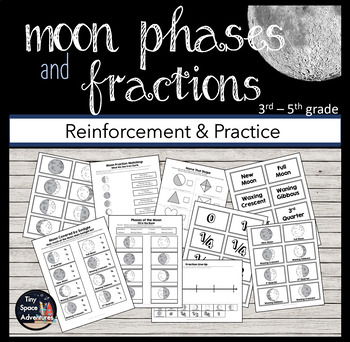Moon Phases & Fractions
Description
A great supplement to any phases of the moon unit! The worksheets in this packet are intended for reinforcement & practice of the phases of the moon and the numerical values that represent how much of the Moon is lit up by sunlight (as seen from Earth).
Classroom stations, reinforcing phases of the moon/fractions or both!
Students will have fun playing Memory with the phases of the moon to sharpen their fraction skills and reinforce the lunar phases. Five additional worksheets are also included.
Supplemental information on the moon and its phases is included.
NOTE: Fractions are based on how the Moon is observed from Earth.
This is a PDF non-editable resource.
Common Core Standards
Grade 3.NF.1: Understand a fraction 1/b as the quatintiy formed by 1 part when a whole is partitioned into b equal parts.
Grade 4.MD.4: Make a line plot to display a data set of measurements in fractions of a unit.
Grade 5.MD.2: Make a line plot to display a data set of measurements in fractions of a unit.
Next Generation Science Standards
MiddleSchool.SpaceSystems
MS-ESS1-1.Develop and use a model of the Earth-sun-moon system to descibe the cyclic patterns of the lunar phases, eclipses of the sun and moon and seasons.
Check out these other Moon related resources:
The Moon's Many Phases
Space Race to the Moon Reading Comprehension
All About the Moon Background Information
Cratering the Moon
Moon Infographic





